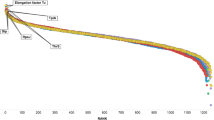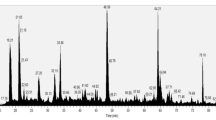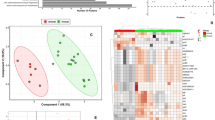Abstract
The surface-associated proteins play a key role in bacterial physiology and pathogenesis, and are the major targets in the development of new vaccines. These proteins contribute to the adaptation of bacteria to different hosts and environments. To study differences at the genomic level, we first sequenced the whole genome of Streptococcus iniae from fish (IUSA-1 strain) and compared it to Streptococcus iniae from human (9117 strain), revealing a high similitude between both strains. To gain further insights into host- and environment-specific differences, we then studied proteins in silico and by High Performance Liquid Chromatography. This approach successfully identified 54 secreted and surface proteins, including several proteins involved in cell wall synthesis and transport of solutes, as well as proteins with yet unknown function. These proteins highlight as interesting targets for further investigation in the interaction between Streptococcus iniae and its environment. Results reported in this study have shown a first analysis about the predicted and experimental associated proteins of Streptococcus iniae isolated from two different hosts: human and fish.


Similar content being viewed by others
References
Agnew W, Barnes AC (2007) Streptococcus iniae, an aquatic pathogen of global veterinary significance and a challenging candidate for reliable vaccination. Vet Microbiol 122:1–15
Baiano J, Barnes AC (2009) Towards control of Streptococcus iniae. Emerg Infect Dis 15:1891
Barinov A, Dudin P, Gregoratti L, Locatelli A, Mentes TO, Nino MA, Kiskinova M (2009) Synchrotron-based photoelectron microscopy. Nucl Instrum Meth A 601:195–202
Bearden SW, Perry RD (1999) The Yfe system of Yersinia pestis transports iron and manganese and is required for full virulence of plague. Mol Microbiol 32:403–414
Beck HC, Madsen SM, Glenting J, Petersen J, Israelsen H, Nørrelykke MR, Antonsson M, Hansen AM (2009) Proteomic analysis of cell surface-associated proteins from probiotic Lactobacillus plantarum. FEMS Microbiol Lett 297:61–66
Benachour A, Morin T, Hébert L, Budin-Verneuil A, Le Jeune A, Auffray Y, Pichereau V (2009) Identification of secreted and surface proteins from Enterococcus faecalis. Can J Microbiol 55:967–974
Benachour A, Ladjouzi R, Le Jeune A, Hébert L, Thorpe S, Courtin P, Chapot-Chartier MP, Prajsnar TK, Foster SJ, Mesnage S (2012) The lysozyme-induced peptidoglycan N-acetylglucosamine deacetylase PgdA (EF1843) is required for Enterococcus faecalis virulence. J Bacteriol 194:6066–6073
Bergmann S, Rohde M, Hammerschmidt S (2004) Glyceraldehyde-3-phosphate dehydrogenase of Streptococcus pneumoniae is a surface-displayed plasminogen-binding protein. Infect Immun 72:2416–2419
Bøhle LA, Riaz T, Egge-Jacobsen W, Skaugen M, Busk ØL, Eijsink VG, Mathiesen G (2011) Identification of surface proteins in Enterococcus faecalis V583. BMC Genom 12:135
Boneca IG, Dussurget O, Cabanes D, Nahori MA, Sousa S, Lecuit M, Psylinakis E, Bouriotis V, Hugot JP, Giovannini M, Coyle A, Bertin J, Namane A, Rousselle JC, Cayet N, Prévost MC, Balloy V, Chignard M, Philpott DJ, Cossart P, Girardin SE (2007) A critical role for peptidoglycan N-deacetylation in listeria evasion from the host innate immune system. Proc Natl Acad Sci 104:997–1002
Brassard J, Gottschalk M, Quessy S (2004) Cloning and purification of the Streptococcus suis serotype 2 glyceraldehyde-3-phosphate dehydrogenase and its involvement as an adhesin. Vet Microbiol 102:87–94
Brown JS, Gilliland SM, Holden DW (2001) A Streptococcus pneumoniae pathogenicity island encoding an ABC transporter involved in iron uptake and virulence. Mol Microbiol 40:572–585
Buchanan JT, Stannard JA, Lauth X, Ostland VE, Powell HC, Westerman ME, Nizet V (2005) Streptococcus iniae phosphoglucomutase is a virulence factor and a target for vaccine development. Infect Immun 73:6935–6944
Buchanan JT, Colvin KM, Vicknair MR, Patel SK, Timmer AM, Nizet V (2008) Strain-associated virulence factors of Streptococcus iniae in hybrid-striped bass. Vet Microbiol 131:145–153
Cabrera G, Xiong A, Uebel M, Singh VK, Jayaswal RK (2001) Molecular characterization of the iron-hydroxamate uptake system in Staphylococcus aureus. Appl Environ Microbiol 67:1001–1003
Carneiro CR, Postol E, Nomizo R, Reis LF, Brentani RR (2004) Identification of enolase as a laminin-binding protein on the surface of Staphylococcus aureus. Microbes Infect 6:604–608
Cheng S, Hu YH, Jiao XD, Sun L (2010) Identification and immunoprotective analysis of a Streptococcus iniae subunit vaccine candidate. Vaccine 28:2636–2641
Choi HS, Kwon MG, Kim MS, Park MA, Kim DW, Park JY, Kim JS, Na YJ, Kim MY, Kim DS, Chae SH, Seo JS (2013) Draft genome sequence of beta-hemolytic Streptococcus iniae KCTC 11634. Genome Announc 1:e00897–e00813
Cottagnoud P, Tomasz A (1993) Triggering of pneumococcal autolysis by lysozyme. J Infect Dis 167:684–690
Drazek ES, Hammack CA, Schmitt MP (2000) Corynebacterium diphtheriae genes required for acquisition of iron from haemin and haemoglobin are homologous to ABC haemin transporters. Mol Microbiol 36:68–84
El Aamri F, Padilla D, Acosta F, Caballero M, Roo J, Bravo J, Vivas J, Real F (2010) First report of Streptococcus iniae in red porgy (Pagrus pagrus, L.). J Fish Dis 33:901–905
El Aamri F, Acosta F, Real F, Padilla D (2013) Whole-genome sequence of the fish virulent strain Streptococcus iniae IUSA-1, isolated from gilthead sea bream (Sparus aurata) and red porgy (Pagrus pagrus). Genome Announc 1:e00025–e00013
Eldar A, Ghittino C (1999) Lactococcus garvieae and Streptococcus iniae infections in rainbow trout Oncorhynchus mykiss: similar, but different diseases. Dis Aquat Org 36:227–231
Eyngor M, Lublin A, Shapira R, Hurvitz A, Zlotkin A, Tekoah Y, Eldar A (2010) A pivotal role for the Streptococcus iniae extracellular polysaccharide in triggering proinflammatory cytokines transcription and inducing death in rainbow trout. FEMS Microbiol Lett 305:109–120
Frossard SM, Khan AA, Warrick EC, Gately JM, Hanson AD, Oldham ML, Sanders DA, Csonka LN (2012) Identification of a third osmoprotectant transport system osmU in Salmonella enterica. J Bacteriol 194:3661–3671
Fu Q, Liu XH, Lu ZH (2013) Glyceraldehyde-3-phosphate dehydrogenase, an immunogenic Streptococcus equi Ssp. zooepidemicus adhesion protein and protective antigen. J Microbiol Biotechnol 23:579–585
Garmory HS, Titball RW (2004) ATP-binding cassette transporters are targets for the development of antibacterial vaccines and therapies. Infect Immun 72:6757–6763
Gilbreth SE, Somkuti GA (2005) Thermophilin 110: a bacteriocin of Streptococcus thermophilus ST110. Curr Microbiol 51:175–182
Heinecke N, Pratt B, Vaisar T, Becker L (2010) PepC: proteomics software for identifying differentially expressed proteins based on spectral counting. Bioinformatics 26:1574–1575
Höltje JV (1998) Growth of the stress-bearing and shape-maintaining murein sacculus of Escherichia coli. Microbiol Mol Biol Rev 62:181–203
Jack RW, Carne A, Metzger J, Stefanović S, Sahl HG, Jung G, Tagg J (1994) Elucidation of the structure of SA-FF22, a lanthionine-containing antibacterial peptide produced by Streptococcus pyogenes strain FF22. Eur J Biochem 220:455–462
Kent WJ (2002) BLAT—the BLAST-like alignment tool. Genome Res 12:656–664
Kim MS, Choi SH, Lee EH, Nam YK, Kim SK, Kim KH (2007) α-enolase, a plasmin (ogen) binding and cell wall associating protein from a fish pathogenic Streptococcus iniae strain. Aquaculture 265(1):55–60
Klockars M, Reitamo S, Weber T, Kerttula Y (1978) Cerebrospinal fluid lysozyme in bacterial and viral meningitis. Acta Med Scand 203:71–74
Krzywinski M, Schein J, Birol İ, Connors J, Gascoyne R, Horsman D, Jones SJ, Marr MA (2009) Circos: an information aesthetic for comparative genomics. Genome Res 19:1639–1645
LaFrentz BR, Shoemaker CA, Klesius PH (2011) Immunoproteomic analysis of the antibody response obtained in Nile tilapia following vaccination with a Streptococcus iniae vaccine. Vet Microbiol 152:346–352
Larkin MA, Blackshields G, Brown N, Chenna R, McGettigan PA, McWilliam H, Valentin F, Wallace IM, Wilm AR, Thompson JD, Gibson TJ, Higgins DG (2007) Clustal W and Clustal X version 2.0. Bioinformatics 23:2947–2948
Lau SK, Woo PC, Luk WK, Fung AM, Hui WT, Fong AH, Chow CW, Wong SS, Yuen KY (2006) Clinical isolates of Streptococcus iniae from Asia are more mucoid and β-hemolytic than those from North America. Diagn Microbiol Infect Dis 54:177–181
Lee VT, Schneewind O (2001) Protein secretion and the pathogenesis of bacterial infections. Genes Dev 15:1725–1752
Locke JB, Vicknair MR, Ostland VE, Nizet V, Buchanan JT (2010) Evaluation of Streptococcus iniae killed bacterin and live attenuated vaccines in hybrid striped bass through injection and bath immersion. Dis Aquat Org 89:117
McPherson DC, Popham DL (2003) Peptidoglycan synthesis in the absence of class a penicillin-binding proteins in Bacillus subtilis. J Bacteriol 185:1423–1431
Milani CJ, Aziz RK, Locke JB, Dahesh S, Nizet V, Buchanan JT (2010) The novel polysaccharide deacetylase homologue Pdi contributes to virulence of the aquatic pathogen Streptococcus iniae. Microbiology 156:543–554
Nanninga N (1998) Morphogenesis of Escherichia coli. Microbiol Mol Biol Rev 62:110–129
Perez-Casal J, Potter AA (2016) Glyceradehyde-3-phosphate dehydrogenase as a suitable vaccine candidate for protection against bacterial and parasitic diseases. Vaccine 34(8):1012–1017
Popham DL, Setlow P (1995) Cloning, nucleotide sequence, and mutagenesis of the Bacillus subtilis ponA operon, which codes for penicillin-binding protein (PBP) 1 and a PBP-related factor. J Bacteriol 177:326–335
Popham DL, Setlow P (1996) Phenotypes of Bacillus subtilis mutants lacking multiple class a high-molecular-weight penicillin-binding proteins. J Bacteriol 178:2079–2085
Rodríguez-Ortega MJ, Luque I, Tarradas C, Bárcena JA (2008) Overcoming function annotation errors in the gram-positive pathogen Streptococcus suis by a proteomics-driven approach. BMC Genom 9:588
Schaumburg J, Diekmann O, Hagendorff P, Bergmann S, Rohde M, Hammerschmidt S, Jänsch L, Wehland J, Kärst U (2004) The cell wall subproteome of Listeria monocytogenes. Proteomics 4:2991–3006
Scott JR, Barnett TC (2006) Surface proteins of gram-positive bacteria and how they get there. Annu Rev Microbiol 60:397–423
Sebulsky MT, Heinrichs DE (2001) Identification and characterization offhuD1 and fhuD2, two genes involved in iron-hydroxamate uptake in Staphylococcus aureus. J Bacteriol 183:4994–5000
Spratt BG (1977) Properties of the penicillin-binding proteins of Escherichia coli K12. Eur J Biochem 72:341–352
Stajich JE, Block D, Boulez K, Brenner SE, Chervitz SA, Dagdigian C, Fuellen G, Gilbert JG, Korf I, Lapp H, Lehväslaiho H, Matsalla C, Mungall CJ, Osborne BI, Pocock MR, Schattner P, Senger M, Stein LD, Stupka E, Wilkinson MD, Birney E (2002) The Bioperl toolkit: Perl modules for the life sciences. Genome Res 12:1611–1618
Tagg J (2004) Prevention of streptococcal pharyngitis by anti-Streptococcus pyogenes bacteriocin-like inhibitory substances (BLIS) produced by Streptococcus salivarius. Indian J Med Res 119:13–16
Tam R, Saier M (1993) Structural, functional, and evolutionary relationships among extracellular solute-binding receptors of bacteria. Microbiol Rev 57:320–346
Tanabe M, Atkins HS, Harland DN, Elvin SJ, Stagg AJ, Mirza O, Titball RW, Byrne B, Brown KA (2006) The ABC transporter protein OppA provides protection against experimental Yersinia pestis infection. Infect Immun 74:3687–3691
Tjalsma H, Lambooy L, Hermans PW, Swinkels DW (2008) Shedding & shaving: disclosure of proteomic expressions on a bacterial face. Proteomics 8:1415–1428
Viswanathan V, Edelstein PH, Pope CD, Cianciotto NP (2000) The Legionella pneumophila iraAB locus is required for iron assimilation, intracellular infection, and virulence. Infect Immun 68:1069–1079
Vollmer W, Tomasz A (2000) The pgdA gene encodes for a peptidoglycanN-acetylglucosamine deacetylase in Streptococcus pneumoniae. J Biol Chem 275:20496–20501
Vollmer W, Tomasz A (2002) Peptidoglycan N-acetylglucosamine deacetylase, a putative virulence factor in Streptococcus pneumoniae. Infect Immun 70:7176–7178
Vuong C, Voyich JM, Fischer ER, Braughton KR, Whitney AR, DeLeo FR, Otto M (2004) Polysaccharide intercellular adhesin (PIA) protects Staphylococcus epidermidis against major components of the human innate immune system. Cell Microbiol 6:269–275
Wang J, Zou LL, Li AX (2013) A novel iron transporter in Streptococcus iniae. J Fish Dis 36(12):1007–1015
Wang J, Wang K, Chen D, Geng Y, Huang X, He Y, Lai W (2015) Cloning and characterization of surface-localized α-enolase of Streptococcus iniae, an effective protective antigen in mice. Int J Mol Sci 16(7):14490–14510
Wei Z, Fu Q, Liu X, Xiao P, Lu Z, Chen Y (2012) Identification of Streptococcus Equi Ssp. zooepidemicus surface associated proteins by enzymatic shaving. Vet Microbiol 159(3–4):519–525
Weinstein MR, Litt M, Kertesz DA, Wyper P, Rose D, Coulter M, McGeer A, Facklam R, Ostach C, Willey BM, Borczyk A, Low DE (1997) Invasive infections due to a fish pathogen, Streptococcus iniae. New England J Med 337:589–594
Wirawan RE, Klesse NA, Jack RW, Tagg JR (2006) Molecular and genetic characterization of a novel nisin variant produced by Streptococcus uberis. Appl Environ Microbiol 72:1148–1156
Wooldridge KG, Williams PH (1993) Iron uptake mechanisms of pathogenic bacteria. FEMS Microbiol Rev 12:325–348
Yajima A, Takahashi Y, Shimazu K, Urano-Tashiro Y, Uchikawa Y, Karibe H, Konishi K (2009) Contribution of phosphoglucosamine mutase to the resistance of Streptococcus gordonii DL1 to polymorphonuclear leukocyte killing. FEMS Microbiol Lett 297(2):196–202
Yang X, He Y, Du K, Wu G, Yu X, Pan GY, He QY (2016). Integrated Translatomics with Proteomics to Identify Novel Iron–Transporting Proteins in Streptococcus pneumoniae Front Microbiol 7
Young KD (2001) Approaching the physiological functions of penicillin-bindingproteins in Escherichia coli. Biochimie 83:99–102
Zhang C, Wang J, Long M, Fan C (2013) gKaKs: the pipeline for genome level Ka/Ks calculation. Bioinformatics 29:645–646
Zhang BC, Zhang J, Sun L (2014) Streptococcus iniae SF1: complete genome sequence, proteomic profile, and immunoprotective antigens. PLoS One 9:e91324
Acknowledgements
We would like to thank Dr. MY Mistou for his assistance and support during the experiment and analysis of samples and Dr. Melody N. Neely for kindly providing the S. iniae 9117 strain.
Author information
Authors and Affiliations
Corresponding author
Ethics declarations
Conflict of interest
The authors declare that they have no conflict of interest.
Additional information
An erratum to this article is available at http://dx.doi.org/10.1007/s11259-017-9688-7.
Rights and permissions
About this article
Cite this article
El Aamri, F., Guillén, J.Á., Padilla, D. et al. Identification of some main Streptococcus iniae associated proteins: relationship. Vet Res Commun 41, 85–95 (2017). https://doi.org/10.1007/s11259-017-9675-z
Received:
Accepted:
Published:
Issue Date:
DOI: https://doi.org/10.1007/s11259-017-9675-z




